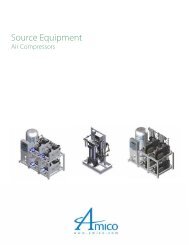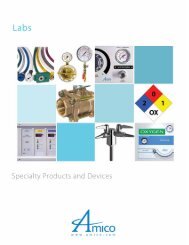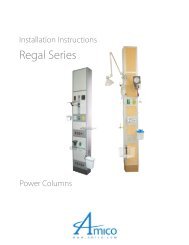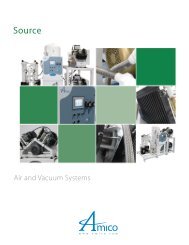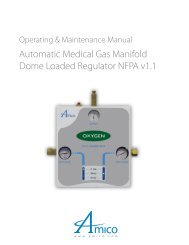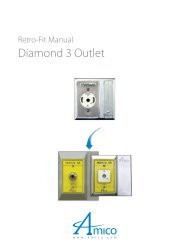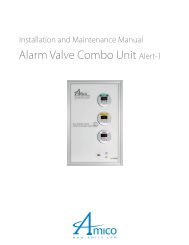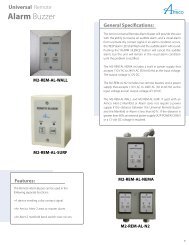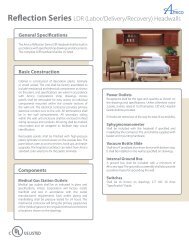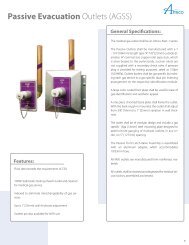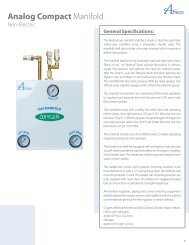You also want an ePaper? Increase the reach of your titles
YUMPU automatically turns print PDFs into web optimized ePapers that Google loves.
Installation and Maintenance <strong>Manual</strong><br />
Digital Automatic<br />
Dental Compact Manifold<br />
w w w . a m i c o . c o m
Table of Contents<br />
User Responsibility 3<br />
Introduction 4<br />
Description Of The Manifold 5<br />
Shipment Details 5<br />
Description Of Parts 5<br />
Pressure Regulators 6<br />
Warning System Components 6<br />
Operating Alarm Systems 7<br />
Safety Features 7<br />
Installation<br />
Receipt And Location 8<br />
Assembly Instructions 8<br />
Dental Manifold Setting 8<br />
Maintenance 10<br />
Trouble Shooting 11<br />
Electrical Faults 11<br />
Appendix - A<br />
Support Bracket Hole Pattern Layout 12<br />
Appendix - B<br />
Control Cabinet Wiring Diagram 13<br />
Appendix - C<br />
Dimensions 14<br />
2 <strong>Amico</strong> Labs
User Responsibility<br />
The information contained in this Installation and Maintenance <strong>Manual</strong>, pertains only to the Digital Automatic Dental<br />
Compact Manifold. This product will perform in conformity with the descriptions contained in this manual, when<br />
assembled, operated, maintained and serviced in accordance with the installation instructions provided.<br />
The manifold must be checked periodically. Parts that are broken, missing, worn, distorted or contaminated, must be<br />
replaced immediately. Should such repair or replacement become necessary, please contact <strong>Amico</strong> labs. Corporation or<br />
their distributors.<br />
All manifolds should not be repaired, or altered without prior written approval of <strong>Amico</strong> Labs Corporation or it’s<br />
distributors. Failure to comply will void all warranty on the manifold.<br />
Statements in this manual preceded by the words WARNING, CAUTION, DANGER and NOTE are of special significance.<br />
Please read these sections carefully.<br />
WARNING: denotes steps which can prevent injury.<br />
CAUTION: denotes steps which can prevent damage to equipment.<br />
www.amico.com 3
Introduction<br />
The Digital Automatic Dental Manifold is a perfect solution for low flow applications. It is designed to accommodate<br />
two cylinders for both Oxygen and Nitrous Oxide. This manifold is Fully Automatic and shall switch from “Bank in Use” to<br />
“Reserve” bank without fluctuation in delivery supply in pressure. For patient safety, the Dental Manifold has a failsafe<br />
feature whereby it will not deliver Nitrous Oxide through the piping system if the oxygen supply pressure is depleted or<br />
turned off.<br />
This manifold shall have a microprocessor based digital display panel. It shall come with four PS 250 high pressure<br />
regulators for the banks of each gas cylinder. Hose assemblies will connect from the PS 250 regulators to the manifold.<br />
This manifold includes a dome-loaded regulators to allow for the remote control of gases and consistent delivery<br />
pressures. The maximum inlet pressure on this regulator is 500 psi (3447 kPa) while the maximum outlet and domeloaded<br />
pressure is 125 psi (862 kPa)<br />
All manifold regulators, piping and valves shall be cleaned for oxygen service.<br />
Features Include:<br />
• Operating and line regulators provided with relief valve<br />
• CGA fittings installed for easy connection<br />
• Isolation valves for both Oxygen and Nitrous Oxide supply line<br />
• Maximum inlet pressure is 3000 psi (20,685 kPa)<br />
• Pressure switches for line and bank pressures to be ordered separately<br />
4 <strong>Amico</strong> Labs
Description of the Manifold<br />
Shipment Details<br />
The package consists of one fully tested Digital Automatic Dental Manifold , hoses are included.<br />
Description Of Parts<br />
The Digital Automatic Dental Manifold is divided into 3 main parts:<br />
Shuttle Valve Assembly<br />
The shuttle valve assembly has been designed to facilitate the automatic switch-over from bank to bank. The shuttle valve<br />
is the heart of the manifold and forms the centre of the control apparatus to ensure uninterrupted flow of gas without<br />
change in the delivery pressure.<br />
When the operating bank pressure falls to a predetermined level, the difference in pressures acting on either side of the<br />
shuttle valve causes change-over to the reserve cylinder bank.<br />
<strong>Amico</strong> has two different types of shuttle valves:<br />
Diaphragm type (LOW Pressure)<br />
This shuttle valve consists of a machined brass body, in two halves. There are two<br />
threaded inlet connections and two outlet connections (nut and nipple CGA-540).<br />
The shaft assembly consists of a stainless steel shaft and a nylon reinforced neoprene<br />
diaphragm, which is sandwiched between two seat plates. Neoprene seats are held<br />
against these plates by seat washers secured by nuts. The shaft assembly fits into the<br />
chamber formed by the body halves, which bolt together and squeeze the diaphragm<br />
sealing one side from the other.<br />
The shaft is free to move from side to side with the diaphragm flexing back and forth. When pressure is introduced from<br />
one side, the shaft assembly takes up it’s initial position with the pressurized side open. As the same pressure is allowed<br />
into the closed side, the shaft remains in the same position since the pressure acts on a reduced diaphragm area, which<br />
does not provide sufficient force to cause switch-over.<br />
When the operating side pressure falls to a specific pressure, the force on the closed side overcomes the force on the open<br />
side and the shuttling occurs changing the supply from one bank to the other. The change in shaft positions is detected<br />
by limit switches, which signals the microprocessor that change-over has occurred.<br />
www.amico.com 5
Pressure Regulators<br />
There are two types of regulators in the <strong>Amico</strong> manifold: The Operating pressure<br />
regulator and the Line pressure regulator. Both types conform to NFPA 99.<br />
Operating (Source) Regulators<br />
There are four operating regulators on every manifold. The regulators are factory preset<br />
for Oxygen and Nitrous Oxide 150 psi.<br />
Pressure Transducer<br />
Pressure transducers monitor the supply pressure of a gas coming into the manifold<br />
cabinet. The gas pressure is converted into a signal that is transferred onto the digital<br />
LED front display. There are two transducers in the manifold cabinet, one for the left<br />
and one for the right pressure bank.<br />
Warning System Components<br />
Forming an integral part of the <strong>Amico</strong> manifold control cabinet are a number of<br />
components whose function is to give continuous visual information as to the state of<br />
operation of the system.<br />
Bank Change-Over Indicators<br />
LED’s on the face of the manifold are controlled by the microprocessor. The<br />
microprocessor interprets the various input signals (pressure in gas cylinders and bank<br />
switch-over), converting the information into a digital display.<br />
The pressure coming into the manifold is measured by the pressure transducer. The transducer sends a signal to the<br />
microprocessor which then converts the signal to a digital display on the left or right bank.<br />
As the shuttle valve changes position (pressure controlled, not microprocessor controlled) from left bank to right bank,<br />
the limit switch is activated. This causes a signal to be sent from the limit switch to the microprocessor. The signal controls<br />
the status LED’s of the left or right bank (in use, ready, empty) and relay for remote monitoring.<br />
6 <strong>Amico</strong> Labs
Operating Alarm Systems<br />
Operating alarm systems are mandatory according to NFPA 99. <strong>Amico</strong> supplies a complete range of operating alarm<br />
units which can be used in conjunction with the <strong>Amico</strong> manifold to provide the required visual and audible signals, in<br />
suitable locations, when change-over from the primary supply to the secondary supply occurs.<br />
The manifold control cabinet contains the required circuitry to send a dry contact signal to the alarm unit when a bank is<br />
empty and change-over occurs. The normally closed internal circuitry is designed to alarm when there is an open<br />
circuit. The depletion of a bank triggers a relay, which renders the alarm circuit open and initiates the alarm signal.<br />
Safety Features<br />
Alert - 2 Series<br />
Gas Service Identification<br />
<strong>Amico</strong> OPERATING manifolds are clearly ALARM labelled for the gas SYSTEMS<br />
that they are intended to be used for. A large nameplate, indicating the<br />
appropriate gas is attached on the cabinet door. The two pipes extending from the top of the cabinet, one for main line<br />
pressure Operating and one alarm for the systems operating are pressure mandatory relief, are according labelled. to NFPA 99. <strong>Amico</strong> supplies a complete range of<br />
operating alarm units which can be used in conjunction with the <strong>Amico</strong> manifold to provide the required<br />
Function visual and Identification audible signals, in suitable locations, when change-over from the primary supply to the<br />
The secondary indicator LED’s supply on the occurs. door are clearly marked to explain their function.<br />
The manifold control cabinet contains the required circuitry to send a dry contact signal to the alarm unit<br />
Cylinder when a Connections<br />
bank is empty and change-over occurs. The normally closed internal circuitry is designed to<br />
The alarm <strong>Amico</strong> when manifold there is is designed an open to circuit. assure that The only depletion cylinders of containing a bank triggers the proper a relay, gas, can which be connected renders to the it. alarm All<br />
cylinder circuit extension open and bar initiates connections the as alarm well as signal. pigtail hose assemblies, comply with CGA Standard B96, “Compressed Gas<br />
Cylinder Valve Outlet and Inlet Connections”.<br />
115VAC<br />
SUPPLY<br />
VOLTAGE<br />
<strong>Amico</strong> Gas<br />
Manifold<br />
C<br />
NO<br />
L N G<br />
C 1 C 2 C 3 C 4 C 5 C 6 C 7 C 8 C 9 C 10<br />
Connect the NC loop to<br />
the appropriate points.<br />
Current Draw:<br />
1 Amp. Max.<br />
www.amico.com 7
Installation<br />
Receipt And Location<br />
The <strong>Amico</strong> manifold should be carefully examined upon receipt. If any damages are found, a claim should be filed with<br />
the transport company and <strong>Amico</strong> Labs.<br />
Any authorized dealers and distributors should also be notified immediately.<br />
Assembly Instructions<br />
Wall Mounting Instructions<br />
The <strong>Amico</strong> manifold is shipped in a semi-assembled condition to facilitate packaging and installation.<br />
Position the collapsible manifold support wall bracket (optional) onto the wall.<br />
Mark the holes, drill and attach suitable anchors (not supplied by <strong>Amico</strong>) into the supporting wall (refer to “Appendix<br />
A”). Bolt the manifold support into position.<br />
Attach the manifold control cabinet to the support using supplied bolts. The cabinet attaches to the front of the wall<br />
bracket.<br />
Testing For Leakage<br />
The following instructions apply to leak testing to be performed on the joints made during assembly and connection<br />
of the <strong>Amico</strong> manifold and not to tests previously made on the piping system.<br />
The connections inside the <strong>Amico</strong> control cabinet have been inspected at the manufacturing plant and DO NOT<br />
require leak testing. In order to determine whether any leaks exist between cylinder extension bar sections or at the<br />
pipeline connections, the system must be pressurized using either oil-free dry air or oil-free dry nitrogen.<br />
1. Connect a cylinder of the manifold service gas to the end connection on each end of the cylinder extension bar<br />
using the copper cylinder connection hose assemblies (pigtails) supplied.<br />
2. Make sure all other outlets are capped with the plug and chain assemblies supplied.<br />
3. Make sure that the high pressure inlet valves of each bank are fully OPEN.<br />
4. “Slowly” open the two cylinder valves closest to the cabinet, one at a time, to pressurize the cylinder extension bar<br />
and to pressurize the pipeline.<br />
5. All outlets from the pipeline, downstream of the manifold, should be closed and thus there should be no flow from<br />
the manifold.<br />
8 <strong>Amico</strong> Labs
Installation<br />
6. Check for leaks at all cylinder extension joints and at the joints where the pipes were connected to the pipeline,<br />
using a commercial leak detector, which is compatible with oxygen.<br />
7. If any leaks are found, the system must be depressurized by bleeding through a convenient pipeline outlet and the<br />
faulty connections must be repaired.<br />
8. The threaded pipe cylinder extension bar connections may be tightened one more turn, maintaining the horizontal<br />
location of the cylinder adapters or a further application of an oxygen service threaded sealant may be required.<br />
9. If the brazed pipeline connections leak, they must be removed, cleaned and then re-brazed following the proper<br />
technique. All repaired joints must be pressure tested as previously.<br />
Dental Manifold Settings<br />
The oxygen line regulator should be set@ 55psi<br />
The N20 line regulator should be set @55psi<br />
Relief valve settings for both regulators are set @ 75 PSI<br />
Note: if there is no flow of oxygen automatically the flow of N2O gas will be shut off<br />
www.amico.com 9
Maintenance<br />
General<br />
The tests and inspections specified below apply only to the <strong>Amico</strong> manifold and not to the medical gas pipeline system<br />
as a whole. They are intended to help ensure the proper operation of the manifold and are not to be interpreted as<br />
repair instructions. Fault finding and repair procedures are given in the Trouble Shooting section of this manual.<br />
Shuttle Valve Preventative Maintenance<br />
Shuttle valves should be inspected for any leaks annually.<br />
Removing the Shuttle Valve<br />
Turn off the gas supply. Disconnect the left and right hand supply lines from the shuttle valve. Disconnect the shuttle<br />
valve outlets from the main bar connections to remove the shuttle valve from the cabinet. Loosen the round head screws<br />
holding the limit switches in place and remove the switches from the shuttle valve.<br />
Installing the Shuttle Valve<br />
Install limit switches and tighten the round head screws to secure the switches in place. Install the replacement (or reconditioned)<br />
shuttle valve by tightening its outlet connections to the center bar. Connect the left hand supply lines<br />
between the left hand operating pressure regulator outlet and the shuttle valve. (Repeat for right hand side) S-L-O-<br />
W-L-Y open the high pressure inlet valve on the left hand header bar.<br />
NOTE: The manifold should now be operating on the left hand cylinder bank via the shuttle valve. Line pressure should<br />
remain at its normal setting.<br />
S-L-O-W-L-Y open the high pressure inlet valve on the right hand header bar. Inspect all connections previously<br />
dismantled for leaks using a commercially available leak detector solution compatible with oxygen.<br />
10 <strong>Amico</strong> Labs
Troubleshooting<br />
WARNING: DO NOT UNDER ANY CIRCUMSTANCES USE HYDROCARBON BASED LUBRICANTS ON<br />
SHUTTLE VALVE PARTS. ONLY USE THE LUBRICANTS SUPPLIED, OR USE A SUITABLE EQUIVALENT,<br />
SPECIFICALLY APPROVED FOR MEDICAL USE AND FOR OXYGEN SERVICE.<br />
WARNING: Fire Hazard. DO NOT permit smoking, or any other source of ignition in area where the<br />
manifold is located, or near the relief valve vent outlet. Be certain that all connections are free of dirt,<br />
grease and oil. These substances burn with great intensity in air, enriched with oxygen, or nitrous<br />
oxide and some gas mixtures.<br />
This section is intended to serve as a general guide for identifying the potential functional problems which may occur<br />
during the operation of <strong>Amico</strong> manifolds.<br />
Components removed for maintenance, must be serviced, repaired and tested only by personnel qualified to work on<br />
equipment used in medical service. Only original manufacturer’s parts as supplied by <strong>Amico</strong> may be used.<br />
Electrical Faults<br />
SYMPTOM CAUSE CORRECTIVE ACTION<br />
No indicator LED’s on front panel<br />
illuminated when gas is flowing<br />
Both Red LED’s are flashing, but both<br />
banks are full<br />
A) Power input. • Check for 110 to 240 VAC.<br />
B) Fuse Blown. • Replace fuse (1 amp).<br />
C) Power present at manifold circuit<br />
board. Check that orange wire is 12 V<br />
and blue wire is 5 V.<br />
D) Power not present at manifold circuit<br />
board.<br />
A) All cylinder valves on both banks are<br />
closed.<br />
• Replace the circuit board.<br />
• Replace the power supply.<br />
Slowly open the cylinder valves on either<br />
side and make sure that both emergency<br />
valves on either side of the manifold are<br />
open.<br />
www.amico.com 11
Appendix A<br />
Support Bracket Hole Pattern Layout<br />
12 <strong>Amico</strong> Labs<br />
~<br />
APPENDIX - K<br />
Support Bracket Hole Pattern Layout<br />
14.50” 15.00”<br />
(381 mm)<br />
4 holes to accommodate<br />
3/8” bolts with anchors<br />
(Not supplied by <strong>Amico</strong>).<br />
Hole size to be determined<br />
by the customer.<br />
4 holes to accommodate<br />
3/8” (10 mm) bolts with anchors<br />
(Not supplied by <strong>Amico</strong>).<br />
Hole size to be determined by<br />
the customer.<br />
Recommended distance:<br />
Recommended distance:<br />
57” from floor to center<br />
of bottom hole.<br />
57” (1448 mm) from floor to<br />
center of bottom hole.<br />
Alert - 2 Series<br />
14.50”<br />
14.50” (368 mm)<br />
Page: 43
Appendix B<br />
Control Cabinet Wiring Diagram<br />
www.amico.com 13
Appendix C<br />
Dimensions<br />
14 <strong>Amico</strong> Labs
Notes
www.amico.com<br />
<strong>Amico</strong> Labs | www.amico.com<br />
85 Fulton Way, Richmond Hill<br />
Ontario, L4B 2N4, Canada<br />
71 East Industry Court, Deer Park<br />
NY 11729, U.S.A<br />
Toll Free Tel: 1.877.264.2697<br />
Toll Free Fax: 1.866.440.4986<br />
Tel: 905.763.7778<br />
Fax: 905.763.8587<br />
Email: info@amico.com<br />
AL DENTAL-MNFLD MANUAL APR 2012



